BIG Buddha
Leshan knows its claim to fame sits on the shoulders of Dafo, its Buddha statute. But those are big shoulders indeed.
By Ron Gluckman/In Leshan, China
WHEN FOLKS IN LESHAN, then a sleepy little village near the base of sacred Mount Emei, set about to put the town on the map, they followed the path of practically every other village in Sichuan Province did some 1,300 years ago; they erected a shrine to honor the Lord Buddha.
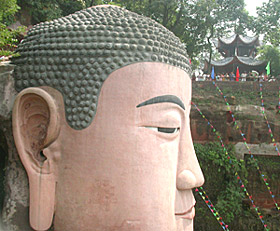 Only they thought big. Very big. As in humongous.
Only they thought big. Very big. As in humongous.
The Leshan Buddha is by far the biggest in the world.
The residents of ancient Leshan had one other interesting brainstorm. Buddha has innumerable representations. The one chosen by Leshan was Maitreya, the future reborn Buddha. The choice was amazingly prophetic because, even though it may have taken centuries, Leshan's Grand Buddha is finally coming into its own.
Credit zealots in Afghanistan, who blasted to bits what many believed was the world's biggest Buddha statues. Actually, even sitting down, Dafo, the gigantic stone Buddha carved into a cliff south of Leshan, has always been many heads taller.
But now, even as the art world reels from the losses in Afghanistan, more attention has naturally turned to Leshan. That's only fitting, since this grand Buddha has been reborn many times.
Construction of the 71-meter-tall Buddha began nearly 1,300 years ago, but took almost a full century to complete. The idea for the multi-generation undertaking is generally attributed to Haitong, one of many ancient monks drawn to the circle of holy sites and temples around nearby Mt. Emei.
Haitong reportedly was concerned about all the boats sinking in the turbulent waters where two rivers, Dadu He and Min He, crashed together in Leshan.
Lighthouses were centuries in the future, but Haitong came up with the next best thing. He figured that a benevolent Buddha seated upon the cliff would watch over the local boatman.
And he was proven right, too, although not in the way he might have imagined. Rocks dropping from this enormous construction site actually filled in the river to the point that the most dangerous swells disappeared.
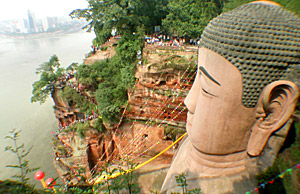 Nowadays, the biggest danger on the water comes from traffic jams. So many boats
sweep in for a close look at Dafo, there is a long wait at docks, and tourist
boats can only pause for a few clicks of the camera before roaring off to make
way for the next cruising craft.
Nowadays, the biggest danger on the water comes from traffic jams. So many boats
sweep in for a close look at Dafo, there is a long wait at docks, and tourist
boats can only pause for a few clicks of the camera before roaring off to make
way for the next cruising craft.
On land, things aren't much better - waits of an hour or more are often required to make the pilgrim's circuit from Dafo's head to toes during the height of Buddha-viewing season.
Dafo sits on a huge throne carved into the cliff of a peninsula that itself looks a bit like a colossal sleeping Buddha. The original Grand Buddha was covered by an enormous wood temple, but that long ago rotted away.
Now, Dafo resides inside a vast tree-filled park, packed with the usual collection of Chinese tourist attractions: stone lions and man-made waterfalls; stalls selling everything from jade trinkets to caged song birds; and crowds posing for pictures in front of pagodas and, naturally, Dafo.
Yet, even jaded jet-setters will struggle to remain unimpressed, if only by the sheer scale of this Grand Buddha. Even sitting down, Dafo is a third taller than the biggest Buddha destroyed in Afghanistan.
His head is bigger than a house. His ears are seven meters long, his nose and eyebrows each 5.6 meters in length. Dafo is a stocky fellow, measuring 28 meters, shoulder to shoulder.
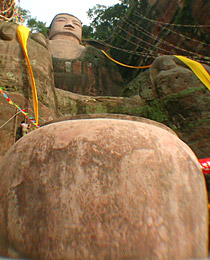 Walking down twisting Nine Turn Cliff Road, precariously cut into the mountain
in the 8th Century, makes one appreciate the enormous accomplishment of this
ancient endeavor. Views are stunning over elbows and knees, taking in the river
scene and Leshan's skyline. When you reach the beach, you find a set of
Gulliver-sized toes over eight meters long.
Walking down twisting Nine Turn Cliff Road, precariously cut into the mountain
in the 8th Century, makes one appreciate the enormous accomplishment of this
ancient endeavor. Views are stunning over elbows and knees, taking in the river
scene and Leshan's skyline. When you reach the beach, you find a set of
Gulliver-sized toes over eight meters long.
Besides the Buddha itself, the surrounding park is worth a stroll, with many temples and stunning views. There are picnic grounds and reasonably-priced food on site.
One stop that shouldn't be missed is the main temple, Lingyun, built in the 7th Century. It features a fabulous exhibit on Buddhas with more detail than most tourists are likely to want to know, unless, of course, you're a Buddha-spotter.
Here, one can soak up statistics on all the other record-setters: world's longest sleeping-Buddha, world's largest indoor; largest bronze Buddha; etc… There are also great pictures of the various restorations of Dafo, including the monumental repairs done in the 1930s.
Leshan, not surprisingly, is happy to hoist its dreams of prosperity atop the shoulders of this enormous Buddha.
With ever more affluent Chinese rediscovering Dafo along with foreign tourists curious about this recent UNESCO World Heritage listing, Leshan boasts busloads of new visitors, along with fancy boat restaurants and a sprinkling of discos.
Still, Leshan is a surprisingly pleasant place, that has after-all, lived with the world's largest Buddha for centuries before the rest of the world paid it much mind. Riverfront development is booming, but Leshan's promenade is peaceful, filled with outdoor cafes and teahouses where the locals play mahjong all night long.
Food in Sichuan Province tends to the spicy, and Leshan does its fare share of hotpots and fire-alarm chili dishes.
Of particular note are various fresh-fish restaurants along Jiading Nanlu, and the understated dumpling stalls around town serving Xiao Long Zheng Jiao, a little satchel of pork and cabbage tied with a broom-twist at the top.
Dunk these delicious nuggets in a dip of oil, chili and sesame seeds and, at $1 for two dozen, you have what must be the best culinary deal on the planet.
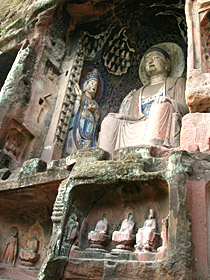 Tourists in Leshan are bound to be bombarded with other Buddhist offerings.
Among several other sites catering to this trade is Dongfang Fodu Gongyuan
(Oriental Buddha Park), which collects several thousand Buddha statues from
around Asia. The centerpiece is reputedly the world's longest reclining Buddha,
measuring 170 meters.
Tourists in Leshan are bound to be bombarded with other Buddhist offerings.
Among several other sites catering to this trade is Dongfang Fodu Gongyuan
(Oriental Buddha Park), which collects several thousand Buddha statues from
around Asia. The centerpiece is reputedly the world's longest reclining Buddha,
measuring 170 meters.
Such crass attempts to cash in on Buddha-mania prompts many tourists to simply move on, to nearby Mt. Emei or Chengdu.
Nobody could be blamed for feeling a bit Bhudda'd out. But there is yet another Buddha worth seeing; or a another two thousand or so at Jianjiang Qianfoyan.
Guidebooks say it's only 2.5 kilometers from Leshan - as maintained by brochures at the site. Likewise the locals on my bus, even as we barreled along on motorway for 45 minutes at speeds ranging from 50-80 kilometers per hour.
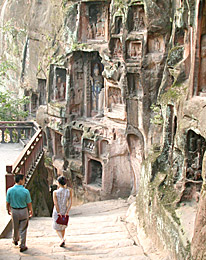 Whatever the distance, it's most rewarding to make the time for Qianfoyan. Qian
means 1,000, but in reality, there are over 2,400 Buddhas carved into the cliffs
here.
Whatever the distance, it's most rewarding to make the time for Qianfoyan. Qian
means 1,000, but in reality, there are over 2,400 Buddhas carved into the cliffs
here.
This is no ordinary roadside attraction, and that's the charm. There are no tourist stalls, no tourist trinkets, rarely even tourists.
Instead, a long ride on winding roads (after the bus) leads to an overgrown riverside park, where you are likely to be alone. It's a marvelous contrast from the mobs at the Grand Buddha.
Instead of lines and the loud roar of mass tourism, here you have time to marvel in serendipitous solitude at this astounding collection of artistic carvings made by unknown ancients.
They come in all sizes, shapes and groupings, with no order to the placement. In fact, Qianfoyan reportedly has the world's largest collection of unique, antique cliff Buddha carvings in the world.
But thankfully, nobody has seemed to notice.
Ron Gluckman is an American reporter who has been roaming around Asia since 1991, when he was based in Hong Kong. Since 2000, he has been based in Beijing, covering China for a wide variety of publications including Silk Road (the magazine of Dragon Airlines) which ran this story in April 2003.
To return to the opening page and index
push here
[right.htm]
